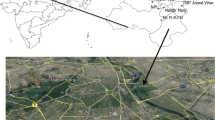Abstract
A workshop on analytical quality control (AQC) of ambient air quality measurement methods for nitrogen dioxide (NO2) and sulphur dioxide (SO2) was conducted by Central Pollution Control Board (CPCB) for officials involved in National Ambient Air Quality Monitoring (NAAQM) in India. Concentrations of NO2 and SO2 were generated by dynamic dilution system under laboratory conditions at low and high levels and measured using static dilution system and wet chemical methods laid down by CPCB under section 16(2)(h) of the air act 1981. CPCB provided the measured values as reference values for comparing the means obtained by the officials participated from thirteen organizations. A tolerance limit of ±15% of the reference values was specified to accept the results. Generated concentrations, which were unknown to the participants, were measured using gaseous sampling assembly (Envirotech APM 411, New Delhi, India), and wet chemical methods laid down by CPCB i.e. the same methodology which is used by the organizations to generate the data of NO2 and SO2 in ambient air. Simultaneously, concentrations were checked by CPCB using automatic analyzers as a check on reference concentration. It is observed that results of automatic analyzers for NO2 and SO2 were within a tolerance of ±5% with %RSD below 3. On the other hand, results of most of the participants showed variability in the measurements with %RSD ranging between ±0.8 and ±88.6 and exceedences of means from the tolerance limit with bias ranging between 1.4 and −59%. To check the cause of high variability in the measurements obtained under identical conditions, duplicate sampling was performed by one of the participants for SO2 at low concentration level. In this study, results of wet chemical methods, automatic analyzers and results of duplicate sampling are analysed statistically to assess the cause of high variability in the measurements. Analysis of t-test and analysis of variance (ANOVA) showed highly significant results for NO2 and SO2 at high concentration levels (α 0.05) and for SO2 at both the levels (α 0.01) respectively indicating some bias is existing either in the sampling or in analytical technique. Duplicate sampling performed to check precision in parallel measurements showed high %RSD indicating the presence of systematic error in sampling technique as the same calibration factor (CF) was used to measure the concentration of duplicate samples. Statistical analysis of flow rates of duplicate sampling showed that the sampling assembly could not maintain the constant flow rate within the ±10% with that measured at the start of the sampling. This resulted in high %RSD and deviation from the reference values for the results of most of the participants, even after accepting ±15% tolerance limit. There is a need to improve and evaluate this gaseous sample collection device under laboratory conditions to generate reliable database of NO2 and SO2 in ambient air.
Similar content being viewed by others
References
Central Pollution Control Board (CPCB), Preliminary Report, Workshop on Analytical Quality Control of Ambient Air Quality Measurement Methods Organized by CPCB, New Delhi, 09–13 Feb. 2004.
Comparative Study on Air Quality Data collected with Equipment supplied by WHO and Equipment developed by National Environmental Engineering Research Institute, Nagpur India. Analysis prepared by Dr. G. Verduyn, Institute of Health and Epidemiology, Brussels, 1979.
Documentation of NIOSH validation test, U.S. Dept of Health, Education and Welfare, Cincinnati, April 1977, pp. 77–185.
Envirotech Instruction Manual, APM 430-411 High Volume Sampler, Vayubodhan Upkaran PVT. Ltd. A-292/1 Okhala Industrial Area, Phase 1, New Delhi.
Handbook on Ambient Air Audit Coordinator, Quality Assurance Division, Environmental Monitoring Systems Laboratory, Research Triangle Park, North Carolina, 27709 Revision 1, 1979.
Review of GEMS/AIR Monitoring Stations, South East Asia Region (Nagpur) Sponsor: UNEP and WHO, Geneva, 1996.
Shotwell, H. P.: 1979, Am. Ind. Hyg. Assoc. 40, 249–253.
Workshop on Air Quality Monitoring, European Intercomparison, Measuring NO, NO2, O3 and SO2, WHO collaborating Center for Air Quality Management and Air Pollution Control in co-operation with UBA pilotstation—Federal Environmental Agency.Vol 4, Report 13, July 2000.
Author information
Authors and Affiliations
Corresponding author
Rights and permissions
About this article
Cite this article
Khaparde, V.V. Inter-Laboratory Comparison of No2 and SO2 Generated by Dynamic Dilution System Under Laboratory Conditions: A Technical Discussion. Environ Monit Assess 116, 217–231 (2006). https://doi.org/10.1007/s10661-006-7393-z
Received:
Accepted:
Issue Date:
DOI: https://doi.org/10.1007/s10661-006-7393-z



